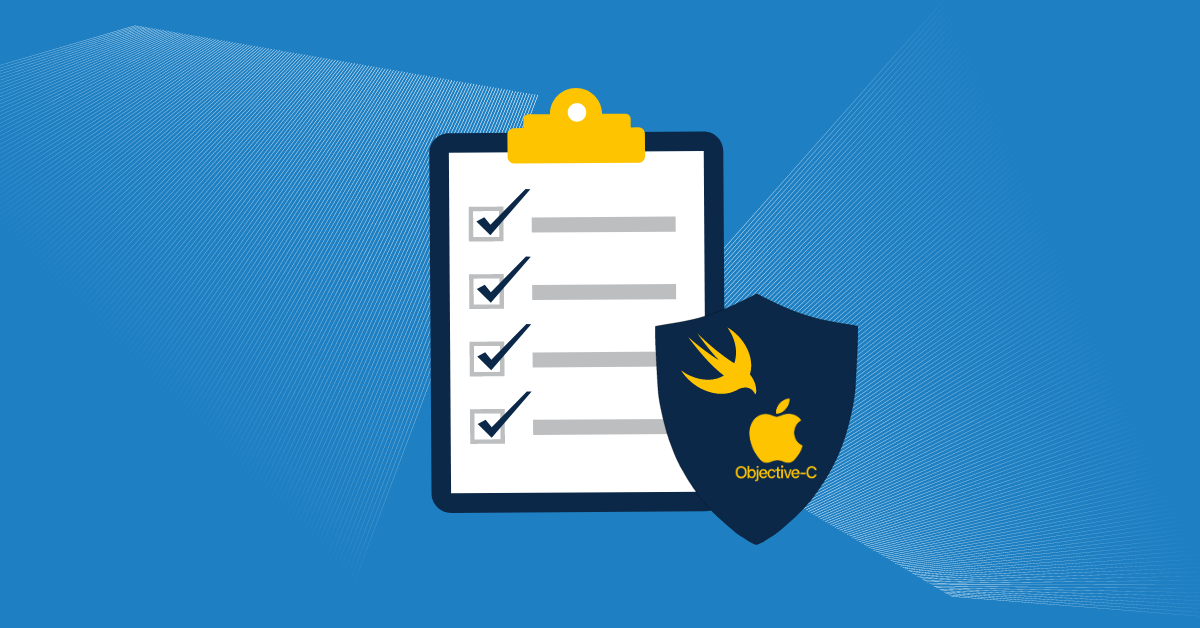
One of the paramount challenges for software developers in any environment is dealing with the overwhelmingly dynamic landscape of security considerations. With cybercrimes of all kinds on the rise and regulations multiplying in response, development teams need to bake security into every phase of the software development lifecycle (SDLC). This comprehensive security checklist will help Swift and Objective-C developers make sure they aren’t overlooking anything.
Use iOS’s Keychain services to securely store sensitive information such as passwords, tokens, and encryption keys. Keychain provides encrypted storage and access control, so only authorized parts of the app can access the stored items.
ATS improves the security of data transmitted over the internet by requiring secure HTTP connections (HTTPS) for all communications between the app and web services. Make sure ATS is enabled and properly configured in the app to protect against eavesdropping and man-in-the-middle attacks.
SSL pinning explicitly validates the server’s digital certificate to ensure that the client is communicating with the intended and authentic server. This significantly reduces the risk of man-in-the-middle attacks.
Debugging code and logs can provide attackers with valuable insights into an app’s operations and potential vulnerabilities. Before putting a build into production, always remove or disable debug code and logs.
Before integrating any third-party library, developers should verify its authenticity and screen it for malicious code or vulnerabilities.
Use data protection APIs to add an additional layer of encryption to the app’s locally stored data. This helps protect the data even if the device is compromised.
Disable screen capture and recording in sensitive parts of an app to prevent confidential data from being leaked through screenshots or screen recordings.
Turn off auto-correction for fields that accept sensitive information to prevent the operating system from storing and suggesting this data. Use masking for input fields to hide sensitive data from shoulder surfing attacks.
Conduct regular dynamic and static analysis of the app’s code to detect vulnerabilities early. Development teams should use automated tools to assist in this process and manually review critical parts of the code.
Follow the Open Web Application Security Project (OWASP) Mobile Security guidelines to protect against common threats and vulnerabilities, including cross-site scripting (XSS), structured query language (SQL) injection, and cross-site request forgery (CSRF) attacks.
Regularly perform comprehensive assessments and testing to identify and fix security flaws before attackers can exploit them. Include mobile apps in all security testing processes.
Apply code hardening practices such as obfuscation and minification to make it harder for attackers to analyze and exploit the app’s code. Use tools like PreEmptive’s Defender for iOS to protect code from hackers trying to reverse engineer access.
To prevent data interception by unauthorized parties, the app should verify the digital certificates of all its external servers.
Engage strong session management measures to prevent unauthorized access. Use tokens securely and ensure sessions are securely terminated when users log out or after a period of inactivity.
Keep track of the reputation of IPs interacting with the app and block those known to be sources of malicious activity.
Make sure the app can detect and respond to suspicious or malicious push notifications to protect users from phishing attacks.
To incorporate the latest security patches and features, development teams should regularly update their tools, including Apple’s Xcode and software development kits (SDKs).
Implement measures to prevent or detect unauthorized debugger attachments, which could be used to reverse engineer the app or modify its behavior at runtime.
Implement safeguards to prevent the accidental leakage of sensitive information through logs, error messages, or data caches. Make error messages generic to avoid providing hackers with unintended access.
Rigorously validate all your apps’ inputs, outputs, and internal processes to prevent exploitation through injection attacks and expose additional vulnerabilities. Before processing or storing data, make sure it is checked for correctness, relevance, and security. By proactively filtering and encoding data, developers can shield apps from many attack vectors.
Use the iOS sandboxing mechanism to effectively isolate app processes and data, minimizing the impact of potential security breaches. By using strict access controls and limiting inter-process communications, developers can ensure each app component operates within a secure environment, reducing the risk of unauthorized access to sensitive information or system resources.
When implementing OAuth2.0 for user authentication, handle all sessions securely to prevent unauthorized access. Use strategies such as securely storing access tokens, refreshing tokens to limit their lifespan, and validating token integrity to guard against tampering.
Be sure to attend to security and rights management right at the beginning. Taking a proactive approach in the early stages of development can ensure security and privacy from the get-go.
Encrypt all network communications using SSL/TLS (Transport Layer Security) protocols to protect data in transit against interception and tampering.
Limit the amount of sensitive information stored on mobile devices, ensuring that all stored data is encrypted and protected. Avoid collecting unnecessary data.
To strengthen the apps’ overall security posture, leverage the full range of iOS security features, such as encryption, access control, and app security assessments.
Apple has strong security standards built in, so take advantage of them. Make sure apps comply with Apple’s App Store Review Guidelines.
Use automated tools to continuously monitor and update services and dependencies to minimize the risk of vulnerabilities.This list of safeguards may seem daunting, but you are not alone. When it comes to protection for desktop, mobile, cloud, and IoT (Internet of Things) applications, developers worldwide trust PreEmptive to protect their intellectual property, sensitive data, and revenue. Request a free trial of Defender for iOS and start protecting your Swift and Objective-C apps today.